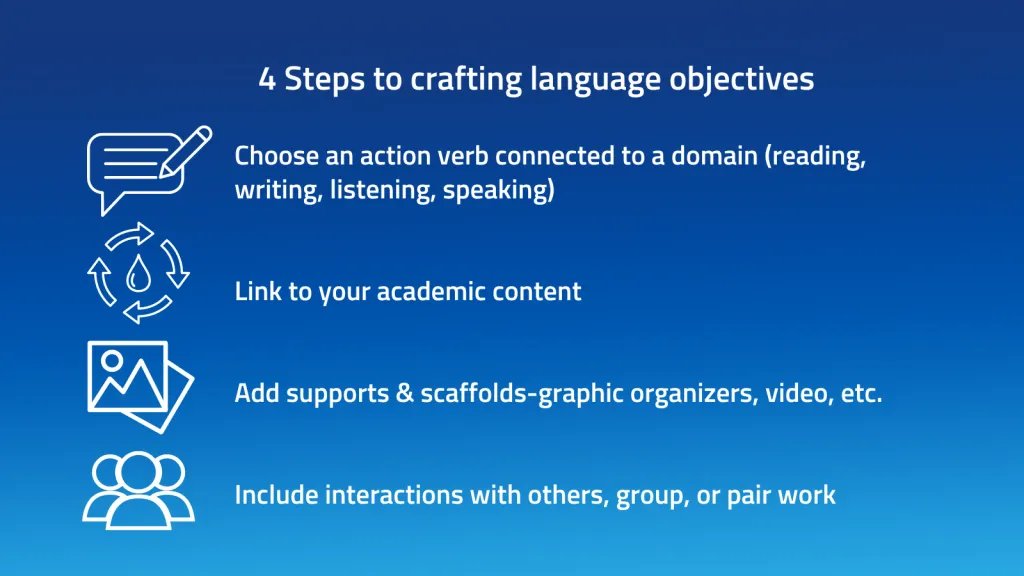Crafting Language Objectives for English Language Learners (ELLs)


Crafting Language Objectives for English Language Learners (ELLs)
The introduction of new standards for English Language Learners has resulted in an increase in rigor and a focus on academic language. With this shift, language service models that isolate language objectives from content, such as pull-out or ESL classes, are becoming less common as school districts refocus on language instruction that is embedded within high-quality, well-scaffolded content instruction.
When creating content-based language instruction, educators must develop unit and lesson content that allows ELs to access the same rigorous, standards-based, grade-level content. In particular, educators need to develop content-based language objectives, which clarify how students will develop language within content instruction.
Alison Balter, an EL leader from Lawrence Public Schools in Massachusetts, worked with Jordan Meranus to share effective strategies that she uses to develop language objectives and integrate them into lessons and units. Below we have outlined some of these key strategies.
What are language objectives?
Language objectives clarify how language instruction is integrated with content, and specifically identify:
- The way ELL students will use language objectives to engage with the content of the lesson and accomplish the content objectives
- The specific components of academic language (vocabulary, language structures, etc.) that students will need to learn to accomplish the language objectives
With advanced planning, language objectives help to identify the scaffolds that teachers must have ready to support differentiated instruction for their ELs.
How do I create language objectives?
When creating language objectives you should begin by clarifying and identifying the following:
- Content objective – identify the content objective that you plan to supplement with language objectives. While you may not create a language objective for every content objective, Alison recommends that you identify the "power objectives", or essential objectives, within a broader unit and use those to create language objectives.
- Knowledge of ELL Student Levels – build an understanding of students’ language proficiency levels so that you know how to adjust the language objectives, differentiate instruction, and apply accommodations for multilingual learners.
- Domain – identify the domain (Listening, Speaking, Reading, Writing) that you plan to focus on. It often helps to think about what you are asking students to do (e.g., a debate-focused content objective would lend itself to a Speaking language objective).
Next, you will use this key information to craft a language objective composed of the following three components:
- Language function – the purpose of the language or linguistic processes required in conveying a message, which includes a verb or action that describes what a student should do (e.g., identify, interpret, evaluate, describe)
- Support – identifies the supports and scaffolds (sensory, graphic, interactive) that the students will need (e.g., vocabulary sheets, visuals, etc.)
- Link to Content – the link to the content topic
Within this structure you will be able to adjust the language function and supports to match students’ different language proficiency levels.
| Subject/Grade Level | 6th Grade Math |
| Content Objectives |
|
| Domain | Writing |
| Language Objective -Levels 1-3 | Compare choices based on real-life rate calculations using a graphic organizer and sentence frames (e.g., ______ is greater than______) |
| Language Objective -Levels 4-5 | Critique choices based on others’ mathematical reasoning from sample solutions to real-life rate problems. |
| Subject/Grade Level | Kindergarten Science |
| Content Objectives | SWBAT track daily weather on a class weather chart, including temperature, wind direction and precipitation |
| Domain | Speaking |
| Language Objective -Levels 1-3 | Describe daily weather conditions from photographs and class charts(i.e., today the weather is rainy) |
| Language Objective -Levels 4-5 | Compare daily weather conditions across different days using class charts (e.g., I know Thursday was hotter than Monday because____) |
| Subject/Grade Level | 6th Grade Writing |
| Content Objectives | SWBAT infer the author’s intended effect of figurative language in a poem. |
| Domain | Writing |
| Language Objective -Levels 1-3 | Give opinions with reasons about the effect of figurative language in a poem using sentence starters and a word bank (e.g., when the authors say ___ it makes the reader feel) |
| Language Objective -Levels 4-5 | Create multiple paragraphs analyzing the effect of figurative language in a poem. * Support was not provided, as most of the advanced students in this group were working at grade level. |